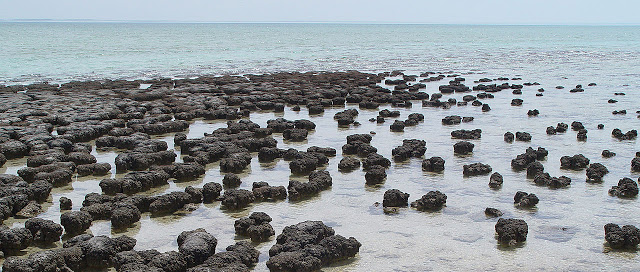
What are Stromatolites?
Stromatolites or stromatoliths are layered accretionary structures formed in shallow water by the trapping, binding and cementation of sedimentary grains by biofilms of microorganisms, especially cyanobacteria (commonly known as blue-green algae). Stromatolites provide some of the most ancient records of life on Earth by fossil remains which date back more than 3.5 billion years ago.
Morphology
A variety of stromatolite morphologies exist including conical, stratiform, branching, domal, and columnar
types. Stromatolites occur widely in the fossil record of the Precambrian, but are rare today. Very few ancient stromatolites contain fossilized microbes. While features of some stromatolites are suggestive of biological activity, others possess features that are more consistent with abiotic (non-organic) precipitation. Finding reliable ways to distinguish between biologically formed and abiotic (non-biological) stromatolites is an active area of research in geology.
Fossil record
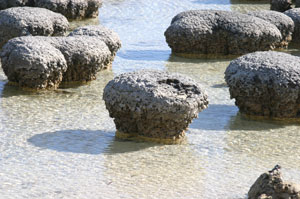 Stromatolites were much more abundant on the planet in Precambrian times. While older, Archean fossil
Stromatolites were much more abundant on the planet in Precambrian times. While older, Archean fossil
remains are presumed to be colonies of cyanobacteria, younger (that is, Proterozoic) fossils may be primordial forms of the eukaryote chlorophytes (that is, green algae). One genus of stromatolite very common in the geologic record is Collenia. The earliest stromatolite of confirmed microbial origin dates to 2.724 billion years ago. A 2009 discovery provides strong evidence of microbial stromatolites extending as far back as 3.450 billion years ago.
Stromatolites are a major constituent of the fossil record for about the first 3.5 billion years of life on earth, peaking about 1.25 billion years ago. They subsequently declined in abundance and diversity, which by the start of the Cambrian had fallen to 20% of their peak. The most widely supported explanation is that stromatolite builders fell victims to grazing creatures (the Cambrian substrate revolution), implying that sufficiently complex organisms were common over 1 billion years ago.
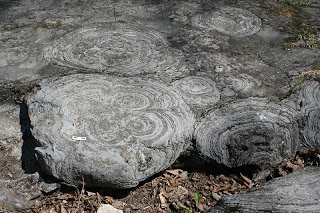
The connection between grazer and stromatolite abundance is well documented in the younger Ordovician evolutionary radiation; stromatolite abundance also increased after the end-Ordovician and end-Permian extinctions decimated marine animals, falling back to earlier levels as marine animals recovered. Fluctuations in metazoan population and diversity may not have been the only factor in the reduction in stromatolite abundance. Factors such as the chemistry of the environment may have been responsible for changes.
While prokaryotic cyanobacteria themselves reproduce asexually through cell division, they were instrumental in priming the environment for the evolutionary development of more complex eukaryotic organisms. Cyanobacteria (as well as extremophile Gammaproteobacteria) are thought to be largely responsible for increasing the amount of oxygen in the primeval earth’s atmosphere through their continuing photosynthesis. Cyanobacteria use water, carbon dioxide, and sunlight to create their food. A layer of mucus often forms over mats of cyanobacterial cells. In modern microbial mats, debris from the surrounding habitat can become trapped within the mucus, which can be cemented together by the calcium carbonate to grow thin laminations of limestone. These laminations can accrete over time, resulting in the banded pattern common to stromatolites. The domal morphology of biological stromatolites is the result of the vertical growth necessary for the continued infiltration of sunlight to the organisms for photosynthesis. Layered spherical growth structures termed oncolites are similar to stromatolites and are also known from the fossil record. Thrombolites are poorly laminated or non-laminated clotted structures formed by cyanobacteria common in the fossil record and in modern sediments.
The Zebra River Canyon area of the Kubis platform in the deeply dissected Zaris Mountains of south western Namibia provides an extremely well exposed example of the thrombolite-stromatolite-metazoan reefs that developed during the Proterozoic period, the stromatolites here being better developed in updip locations under conditions of higher current velocities and greater sediment influx.
Modern occurrence
Modern stromatolites are mostly found in hypersaline lakes and marine lagoons where extreme conditions due to high saline levels exclude animal grazing. One such location is Hamelin Pool Marine Nature Reserve, Shark Bay in Western Australia where excellent specimens are observed today, and another is Lagoa Salgada, state of Rio Grande do Norte, Brazil, where modern stromatolites can be observed as bioherm
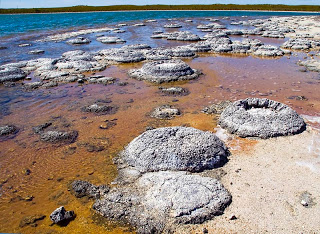
(domal type) and beds. Inland stromatolites can also be found in saline waters in Cuatro Ciénegas, a unique ecosystem in the Mexican desert, and in Lake Alchichica, a maar lake in Mexico’s Oriental Basin. The only open marine environment where modern stromatolites are known to prosper is the Exuma Cays in the Bahamas.
Very recently, the fifth Chlorophyll: Chlorophyll f was discovered by Dr. Min Chen from stromatolites in Shark Bay.
Modern freshwater stromatolites
Laguna Bacalar in Mexico’s southern Yucatán Peninsula in the state of Quintana Roo, has an extensive formation of living giant microbialites (that is, stromatolites or thrombolites). The microbialite bed is over 10 km (6.2 mi) long with a vertical rise of several meters in some areas. These may be the largest sized living freshwater microbialites, or any organism, on Earth.
A little further to the south, a 1.5 km stretch of reef-forming stromatolites (primarily of the Scytonema genus)
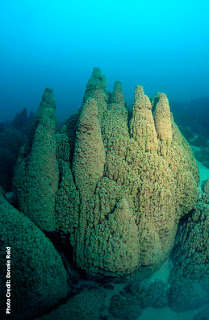
occurs in Chetumal Bay in Belize, just south of the mouth of the Rio Hondo and the Mexican border.
Freshwater stromatolites are found in Lake Salda in southern Turkey. The waters are rich in magnesium and the stromatolite structures are made of hydromagnesite.
Another pair of instances of freshwater stromatolites are at Pavilion and Kelly Lakes in British Columbia, Canada. Pavilion Lake has the largest known freshwater stromatolites and has been researched by NASA as part of xenobiology research. NASA, the Canadian Space Agency and numerous universities from around the world are collaborating on a project centered around studying microbialite life in the lakes. Called the “Pavilion Lake Research Project” (PLRP) its aim is to study what conditions on the lakes’ bottoms are most likely to harbor life and develop a better hypothesis on how environmental factors effect microbiolite life. The end goal of the project is to better understand what condition would be more likely to harbor life on other planets. There is a citizen science project online called “MAPPER” where anyone can help sort through thousands of photos of the lake bottoms and tag microbiolites, algae and other lake bed features.
Microbialites have been discovered in an open pit pond at an abandoned asbestos mine near Clinton Creek, Yukon, Canada. These microbialites are extremely young and presumably began forming soon after the mine closed in 1978. The combination of a low sedimentation rate, high calcification rate, and low microbial growth rate appears to result in the formation of these microbialites. Microbialites at an historic mine site demonstrates that an anthropogenically constructed environment can foster microbial carbonate formation. This has implications for creating artificial environments for building modern microbialites including stromatolites.
A very rare type of non-lake dwelling stromatolite lives in the Nettle Cave at Jenolan Caves, NSW, Australia. The cyanobacteria live on the surface of the limestone, and are sustained by the calcium rich dripping water, which allows them to grow toward the two open ends of the cave which provide light.










